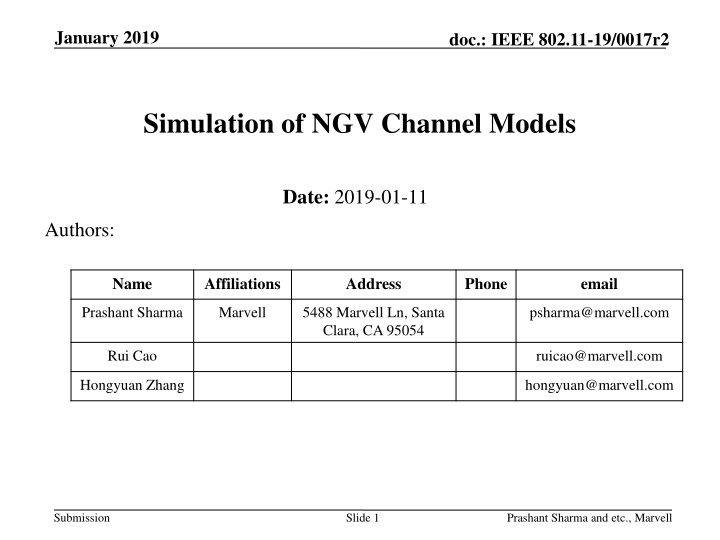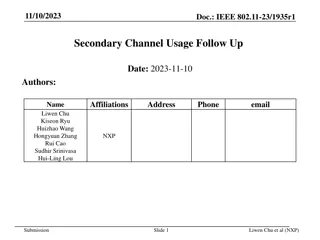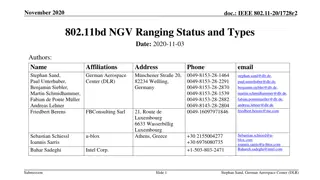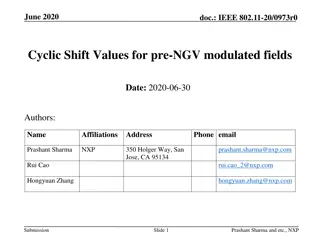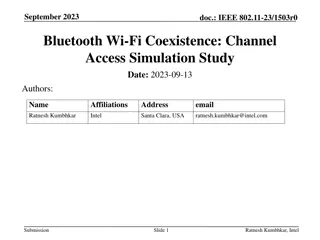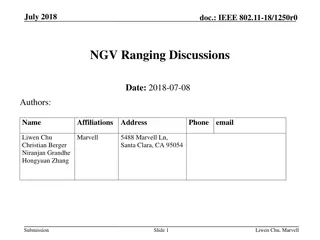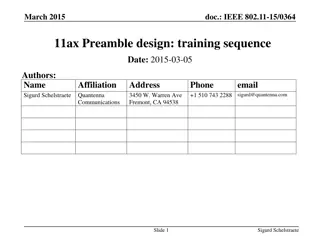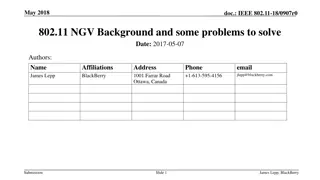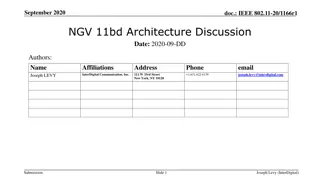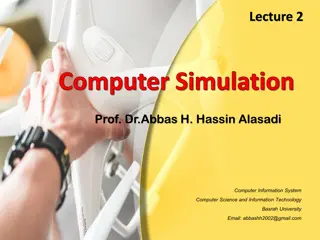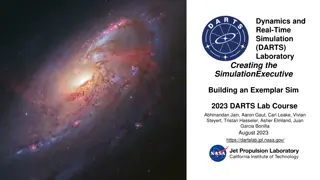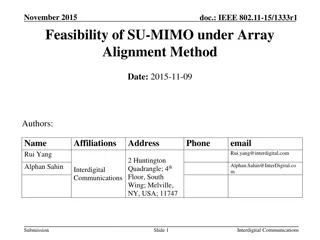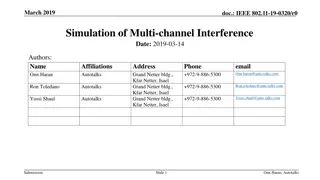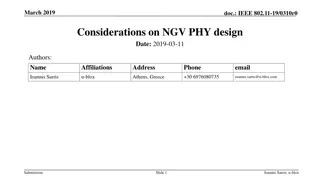Simulation of NGV Channel Models for IEEE 802.11-19/0017r2
This document discusses the simulation methodology for generating Car-to-Car (C2C) channels based on power, delay, and Doppler parameters specified in IEEE 802.11-19/0017r2. The proposed PHY impairment models for NGV link-level simulations are also presented, along with details on C2C channel models for different scenarios. Recommendations for accurate tap delay modeling and sampling rates are provided to enhance simulation accuracy.
Download Presentation

Please find below an Image/Link to download the presentation.
The content on the website is provided AS IS for your information and personal use only. It may not be sold, licensed, or shared on other websites without obtaining consent from the author.If you encounter any issues during the download, it is possible that the publisher has removed the file from their server.
You are allowed to download the files provided on this website for personal or commercial use, subject to the condition that they are used lawfully. All files are the property of their respective owners.
The content on the website is provided AS IS for your information and personal use only. It may not be sold, licensed, or shared on other websites without obtaining consent from the author.
E N D
Presentation Transcript
January 2019 doc.: IEEE 802.11-19/0017r2 Simulation of NGV Channel Models Date: 2019-01-11 Authors: Name Affiliations Address Phone email Prashant Sharma Marvell 5488 Marvell Ln, Santa Clara, CA 95054 psharma@marvell.com Rui Cao ruicao@marvell.com Hongyuan Zhang hongyuan@marvell.com Submission Slide 1 Prashant Sharma and etc., Marvell
January 2019 doc.: IEEE 802.11-19/0017r2 Introduction Car-to-Car (C2C) channel models have been proposed for NGV studies [1]. In this contribution, we present a methodology to generate the C2C channels based on the power, delay and doppler parameters as specified in [1]. We also propose the PHY impairment models to be used in the NGV link-level simulations. Submission Slide 2 Prashant Sharma and etc., Marvell
January 2019 doc.: IEEE 802.11-19/0017r2 C2C Channel Model Recap [1] Table 1: Rural LOS Parameters Table 4: Highway LOS Parameters Tap1 Tap2 Tap3 Units dB ns Km/h Tap1 Tap2 Tap3 Tap4 Units Power Delay Doppler Profile Power Delay Doppler Profile 0 0 0 -14 83 90 -17 183 -54 0 0 0 -10 100 126 -15 167 -90 -20dB 500ns 162Km/h HalfBT HalfBT HalfBT Static HalfBT HalfBT Static Table 2: Urban Approaching LOS Parameters Table 5: Highway NLOS Parameters Tap1 Tap2 Tap3 Tap4 Units Tap1 Tap2 Tap3 Tap4 Units -7dB 700ns 162Km/h HalfBT Power Delay Doppler Profile 0 0 0 -8 -10 183 -29 -15 dB 333 ns 90Km/h HalfBT Power Delay Doppler Profile 0 0 0 -2 -5 117 43 200 126 433 -90 Static HalfBT HalfBT Static HalfBT HalfBT Table 3: Urban Crossing NLOS Parameters Tap1 Tap2 Tap3 Tap4 Units Power Delay Doppler Profile 0 0 0 -3 -5 -10dB 533ns 108Km/h HalfBT 267 54 400 -18 Static HalfBT HalfBT Five C2C channel models to cover different scenarios Main tap (1st tap) always has zero Doppler, and relative Doppler is modeled on other taps. Submission Slide 3 Prashant Sharma and etc., Marvell
January 2019 doc.: IEEE 802.11-19/0017r2 Delay Model C2C channel models fixed tap delays at nano-second level. Sampling rate of 10MHz gives time resolution of 100ns. Tap delays cannot be modeled accurately at this time resolution. We suggest the simulation sampling rate to be at least 80MHz. Provides a resolution of at least 12.5ns. Good enough to model the tap delay for all C2C models. Each tap delay will be translated to the nearest resolvable tap index. The higher sampling rate can also be beneficial for ACI simulations. Submission Slide 4 Prashant Sharma and etc., Marvell
January 2019 doc.: IEEE 802.11-19/0017r2 Doppler Model C2C channels specify biased doppler profile for all channel taps. There are different ways to model the doppler [2]: Classic Bathtub using Jakes model, Dents model, etc. Offset Classic Bathtub Asymmetric uniform Pure doppler We propose to choose pure Doppler method: Doppler shift Every tap doppler is modeled as a single Doppler shift Captures the worst case instantaneous Doppler scenario Helpful in stress testing the performance Very simple to model, while other models needs to have knowledge on the number of reflectors, reflector phase, and etc. Submission Slide 5 Prashant Sharma and etc., Marvell
January 2019 doc.: IEEE 802.11-19/0017r2 C2C Channel Model Channel is modeled as tapped delay line with Doppler shift ? ?,? = ?1+ ??exp(?2???t) (? ??) ?=2 where, ?? is the channel for each delay tap at time t =0 and modelled as complex Gaussian. The variance follows the normalized power profile. ?1 is static, i.e. no Doppler shift For all other taps, exp(?2???t) models Doppler frequency shift of ?? Hz for the ?th tap Channel evolves on a per sample basis ? has the resolution of sample time (for example, 1/80MHz) Submission Slide 6 Prashant Sharma and etc., Marvell
January 2019 doc.: IEEE 802.11-19/0017r2 C2C Channel Model (contd.) Rayleigh fading coefficient ?? is generated as: ??= ??+ ??? where, ?? ~ ? ?, ??and ?? ~ ? ?, ??are independent normal random variables ??? model with the total power normalized to 1. scales according to the power distribution as specified in the channel Submission Slide 7 Prashant Sharma and etc., Marvell
January 2019 doc.: IEEE 802.11-19/0017r2 PHY Impairments PHY impairments will affect the performance evaluation of the any future proposals. We suggest to follow 802.11ac functional requirement document [3] to define the PHY impairments for 802.11bd. Summary(from [3]) PA Non-linearity Use RAPP PA model as specified in document 00/294 with p = 3. Carrier Frequency Offset Randomly chosen from [-20 , 20] ppm with a uniform distribution. Phase noise The phase noise will be specified with a pole-zero model PSD(0) = -100 dBc/Hz Pole frequency fp = 250 kHz Zero frequency fz = 7905.7 kHz Slide 8 Submission Prashant Sharma and etc., Marvell
January 2019 doc.: IEEE 802.11-19/0017r2 Simulation Settings Packet size : 300 bytes Packet format : 11p BCC Coding with DFE Channel tracking Number of channel realizations: 1000 Rx processing: Ideal timing CFO estimation and compensation in preamble portion CPE estimation and compensation in data portion Impairments: On/Off CFO Phase Noise Submission Slide 9 Prashant Sharma and etc., Marvell
January 2019 doc.: IEEE 802.11-19/0017r2 Results: Rural LOS PHY impairments have a noticeable impact on the performance of higher order QAMs for 11p Submission Slide 10 Prashant Sharma and etc., Marvell
January 2019 doc.: IEEE 802.11-19/0017r2 Results: Highway LOS PHY impairments have a noticeable impact on the performance of higher order QAMs for 11p Submission Slide 11 Prashant Sharma and etc., Marvell
January 2019 doc.: IEEE 802.11-19/0017r2 Results: Urban Approaching LOS PHY impairments have a noticeable impact on the performance of higher order QAMs for 11p Submission Slide 12 Prashant Sharma and etc., Marvell
January 2019 doc.: IEEE 802.11-19/0017r2 Results: Highway NLOS Fast channel variation dominates the effect of PHY impairments for high doppler NLOS channel Submission Slide 13 Prashant Sharma and etc., Marvell
January 2019 doc.: IEEE 802.11-19/0017r2 Results: Urban Crossing NLOS PHY impairments have a noticeable impact on the performance of higher order QAMs for 11p Submission Slide 14 Prashant Sharma and etc., Marvell
January 2019 doc.: IEEE 802.11-19/0017r2 Summary Suggested a methodology to generate C2C channels. Need to oversample in order to model tap delay correctly Use pure Doppler for each complex Gaussian channel tap Channel evolves on a per sample basis Proposed to include PHY impairments based on 11ac in the simulation model for 11bd. Provided simulation results for 11p under all C2C channels as a benchmark to compare with any future proposals. Suggest all interested personnel to simulate and calibrate their simulators for future proposals. Submission Slide 15 Prashant Sharma and etc., Marvell
January 2019 doc.: IEEE 802.11-19/0017r2 Reference [1] Hongyuan Zhang and etc., 11-18-0858-00-0ngv-c2c-channel-model-overview [2] Malik Kahn, 11-14-0259-00-0reg-v2v-radio-channel-models [3] Peter Loc, Minho Cheong, 11-09-0451-16-00ac-tgac-functional-requirements- and-evaluation-methodology Submission Slide 16 Prashant Sharma and etc., Marvell
January 2019 doc.: IEEE 802.11-19/0017r2 Appendix Submission Slide 17 Prashant Sharma and etc., Marvell
January 2019 doc.: IEEE 802.11-19/0017r2 Results: AWGN Submission Slide 18 Prashant Sharma and etc., Marvell
